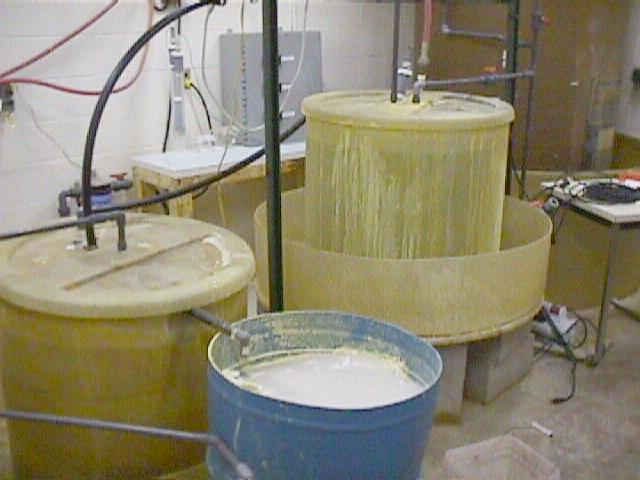
| CHEMICAL ENGINEERING HOME |
| PROSPECTIVE STUDENTS |
| HYDROMETALLURGY |
| INSTITUTE OF MATERIALS PROCESSING |
| PILOT PLANT |
| ORE SAMPLE |
| SEMINAR |
HYDROMETALLURGY
Innovative Bioreactor Technology for the Metals Industry
 SAAB-FIG
SAAB-FIG
Stand-Alone Automated
Bioreactor
for Ferric Ion Generation
- U.S. Patent No. 6,043,022: D. R. Lueking and C. C. Nesbitt, "Apparatus for the Generation and Use of Ferric Ions," Issued March 28, 2000.
- U.S. Patent No. 5,827,701: D. R. Lueking and C. C. Nesbitt, "Method for the Generation and Use of Ferric Ions", Issued October 27, 1998.
Brief Summary:
Drs. Lueking and Nesbitt have developed a process whereby bacterial cells are utilized to produce ferric ions
(Fe+3) on a continual basis. The acronym SAAB-FIG (Stand-Alone Automated Bioreactor for Ferric Ion Generation) is used to
refer to this process. This process can provide a source of cheap ferric ions that can be utilized in a variety of mining and other
applications. MTU owns and operates a pilot scale facility able to handle and process as much as 2 tons/day of material for
application testing.
Specific Applications
-
Mining Process for Gold
The recovery of gold from sulfidic ores generally requires oxidative reactions to remove sulfides (i.e. pyrite) that surround the gold. Oxidation of the sulfides in the ore is usually conducted at high temperatures (i.e. roasting and autoclaving) which is capital intensive and operationally expensive. Ferric ions produced by the SAAB-FIG technology perform this oxidation economically.
-
Desulfurization of Coal
To conform to environmental guidelines, coal companies must reduced the sulfur content of their coal. The major sulfur component in coal is the inorganic compound pyrite. Ferric ions produced by the SAAB-FIG process could oxidize the pyrite and provide an economical means for its removal.
-
Reprocessing of Scrap Metal
Metals, such as copper, zinc and nickel, are readily dissolved under oxidizing conditions. The ferric solutions produced by the SAAB-FIG process quickly oxidize and dissolve these metals. Once dissolved, the metals are readily recoverable for resale.
-
Additional Metals that can be Processed
Uranium ores, rare earth metals, vanadium and most transition metals can be oxidized by ferric solutions produced by SAAB-FIG. The direct dissolution, oxidation or recovery of these metals is possible with these solutions.
-
Environmental Processing
Ferric/ferrous chemistry is a known commodity that can be exploited in several ways. Arsenic may be quantitatively removed from water by precipitation with Fe+3. The formation of ferric and ferrous hydroxide can lead directly to the removal and recovery of trace metals, such as copper, chromium, and cadmium, through co-precipitation. SAAB-FIG solutions may be used in municipal wastewater treatment plants to remove dissolved metals and noxious gases while increasing operation efficiency as low-cost flocculant.
MTU Patented Technology
-
The availability of a cheap source of ferric ions to use as oxidants will allow mining companies to economically recover precious metals from low-grade ores that are not currently being mined. This expands their total recoverable reserves of gold.
-
The SAAB-FIG process can be automated to provide a continual source of ferric ions at reduced costs.
-
In some instances, the SAAB-FIG process can utilize recycled solutions from material treatment to further reduce the cost of metal recovery.
-
The SAAB-FIG process consists of essentially tanks and pumps; therefore, the capital investment to implement and operate is affordable. Immediate paybacks can be realized with implementation.
-
Applications of the SAAB-FIG process are not limited to mining processes. The SAAB-FIG process can be used for numerous applications (i.e. coal desulfurization, scrap metal processing, etc.) where a powerful, cheap oxidant is required.
The SAAB-FIG process provides a cheap source of ferric ions that can be generated on site at a low capital cost ($700/tpd
capacity versus $22,000/tpd for autoclaving) and a low operating cost (<5 cents/lb. Fe+3 versus 70 cents/lb.
commercial).
©
Copyright
2007,
All Rights Reserved Michigan
Technological University is an equal opportunity educational institution / equal opportunity
employer
|